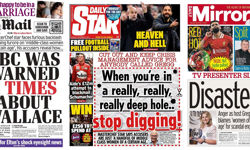Brace yourself. If you are working for a local newspaper, you are in for radical changes. I don't mean more tinkering with subbing hubs, dabbling with online models and the prolonged death by a thousand cuts.
Local and regional publishers are now facing up to a stark reality. If their businesses are to be viable in 2012, the cost of producing them has to change dramatically.
We have seen the signs. Dailies are becoming weeklies; non-profitable titles will be closed. Those newspapers that remain will be a very different model. They will have fewer people, outsource their production, cultivate content from new sources and focus purely on what readers and advertisers want.
But while the local newspaper business may be fighting for its life - the journalism, at least in some places, is thriving. This was brought home to me again while chairing the judges in this year's Regional Press Awards.
The awards, resurrected by the Society of Editors and attracting more than 700 entries, culminated in a swanky lunch hosted by Nick Ferrari in London in May. There were 54 judges, including former national and regional editors, professors, digital experts, writers and designers. I was impressed by their commitment and expertise. They were impressed too… by the quality of the entries. One wrote: "This has been bloody difficult to judge, with such a genuinely high-class entry. I feel really guilty that I have had to narrow it down to six." Another said, "the quality of writing has blown me away." The judges from the nationals were surprised that the death of local newspapers has been greatly exaggerated. Against a background of smaller staffs, deskbound reporters, rewritten handout syndrome and so-called churnalism - there is clearly still investment in real journalism.
I have long been involved with the awards because I believe they are crucial for the newspaper industry. If we don't applaud our business, then who will? But they also give us an opportunity to learn from those at the top of their game. So what can we take away from this year's awards?
The Irish News
Let's start with the Newspaper of the Year, the Irish News. There are many things that set it apart. It is family-owned, with the industrious and innovative Fitzpatricks very much at the coalface.
It has an astonishing sales record. In 1994 the paper was selling 44,072. In the latest ABC figures, its circulation was higher, at 44,222. No other newspaper in the land (with the exception of the Guernsey Press and Jersey Evening Post) comes close to that kind of performance.
Unlike most regional newspapers, the paper also has a complete paywall. Readers can buy a turnpage version but nothing is out there. As editor Noel Doran explains, it is a policy designed to protect the printed copy. "After investing quite heavily in our website and finding it almost impossible to generate any revenue, we went for a subscription model. The response has been limited, but it has protected our print circulation and avoided costing us any more money."
What really bowled over the judges, though, was the Irish News's commitment to in-depth reporting. It dedicated 20 pages to the Saville report. The grammar schools issue, the church in crisis and the policing and justice deal were all given multi-page analysis.
Readers know that if a major issue arises in Northern Ireland, the Irish News will get under its skin. Little surprise that the paper had two journalists - Bimpe Archer and Allison Morris - nominated for reporter of the year. Morris's winning portfolio included a three-page interview with London bomber Dolours Price and another three-page Q&A with an 'army council member' of an active dissident republican group. The paper backs all of this up with campaigning voice. The Q&A was part of a 'We Say Stop' special edition.
Doran reckons the Irish News's prolonged success is also down to continual change.
"We have quite deliberately re-invented the paper on three occasions. The first was a result of the paramilitary ceasefires of 1994. Until then, the Irish News had been a relatively small paper which relied on its coverage of violence and upheaval for its survival. When the daily diet of shootings and bombings began to fade away, a number of media commentators suggested that the Irish News would face an inevitable decline.
"Instead, we were able to broaden our appeal by overhauling our approach to health, education, business, the environment and particularly sport, and we also became involved in some ground-breaking political initiatives. Our readers liked what we were doing, we were able to recruit new journalists and circulation prospered.
Since then, the paper became the first daily Berliner in the UK (well ahead of the Guardian), with almost every aspect of its content reviewed. It moved to a compact in 2005 and again re-assessed its content. "We would like to think that we have a history of introducing change at a time of strength rather than weakness," says Doran.
Perhaps the biggest reason for the Irish News's continued success has been its sport. “It is difficult to explain the importance of the Gaelic Athletic Association to a non-Irish audience,” says Doran. “But the biggest individual sales of the Irish News over the last 20 years have all been linked to GAA matches.”
Doran also believes competition keeps his paper and its journalists on their toes. Belfast, a small city, is home to three dailies and 16 other titles from London, Dublin and Glasgow circulate there each morning. "It only goes to prove that competition is at the heart of journalism," he concludes.
The Essex Chronicle
The leafy villages of Chignal Smealy, Mashbury and Writtle couldn't be further away from the urban world of post-troubles Belfast. But these are among the communities served by the winner of the Weekly Newspaper of the Year (above 20,000 circulation), the Essex Chronicle.
Its energetic editor, Alan Geere, brings 30-plus years' experience to the title and he too insists on investigative community reporting. One of his campaigns culminated in the resignation of the council chief executive. Another looked at the expenses of Essex county councillors, highlighting the wolfing down of £7,000 worth of biscuits and £15,000 worth of coffee at taxpayers' expense. The paper used a front page cartoon to hammer home the point. "What other weekly paper regularly uses cartoons?" asks Geere.
His mantra is new, better and different content, something he continually preaches to his young team. You get a lot for your 75p in the Chronicle - a minimum of 72 pages for the main book with a selection of supplements. The key though is certainly not quantity. This is not a paper filled with every cough and splutter of institutional news.
"It is easy to sit back and fill your paper with 'prescription news' or stories that other people want you to put in the paper," says Geere. "Businesses, councils, statutory bodies and charities have all become media savvy and provide a ceaseless menu of page-ready stories and pictures."
"Most of them will make a brief at best for us. We'll be pursuing our own stories from FoI requests, social media follow-ups and good old fashioned talking to people. It's amazing what can be found simply by walking around with your eyes open!"
Digital innovations
Elsewhere at the awards, the Digital Innovation category inevitably caught the eye.
The winner was the Manchester Evening News which analysed the tweets of Manchester Police over 24 hours. NCJ Media in Newcastle was highly commended for using digital media to tell the story of Raul Moat. Graham Lovelace, chairman of the digital judges, says they wanted to reward experimentation, and offer examples that other newspaper websites could learn from. They were specifically looking for:
* New ways of engaging audiences, interacting with them; increasing reach and usage by integrating social media and live-blogging
* New ways of presenting and organising information, such as visualisation tools, infographics, interactive timelines and tagging
* New platforms and devices, such as mobile and tablets
Lovelace, a former editor-in-chief at Teletext, says: "We found many good examples; in particular the use of new tools and techniques that enhance the online telling of fast-moving or complex stories. The winner and runner-up both stood out. Among the shortlisted, I thought the Birmingham Mail's strategy of getting alongside its online community and making media partners out of an army of local bloggers pointed the way. The EDP's Pinkun.com oozed with interactive engagement."
All good stuff. But… there's a but.
"On too many occasions, innovations were buried within template-driven websites that failed to market these new approaches and techniques”, says Lovelace. "I appreciate the cost issue here. News groups have invested in content management systems and publishing platforms that impose design restrictions, and routinely busting the CMS requires additional skills and expenditure.
"But some blogsites now look better than professional media websites. Which is why, as a judging panel, we call on the regional press to make design and usability a top priority."
Apart from picking up ideas from digital and the newspaper categories, there was excellence to be found in writing, design and photography. The campaigning category was particularly strong. You can check out the winners, the shortlists and their work at www.theregionalpressawards.org.uk.
I have to say that chairing the judges was, once again, an uplifting experience and the day itself, mixing with colleagues I haven't seen for years, was a joy. Congratulations to all the winners and to Bob Satchwell and his team at the Society of Editors for reviving the awards. Back at our desks, though, we are still faced with the sobering challenge. How do we harness the editorial expertise and enthusiasm for considerably less cost, where do we find new revenue and how do we ensure local newspapers become viable and long-term enterprises? Perhaps next year, we should introduce awards for the most successful editorial business and the most entrepreneurial journalist.










